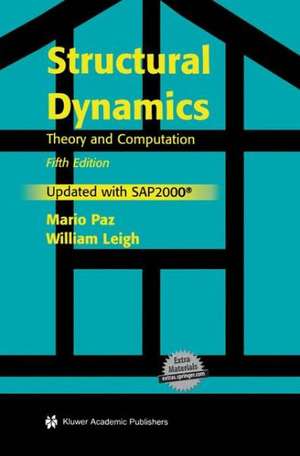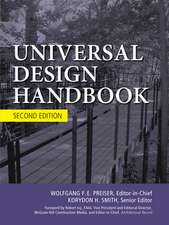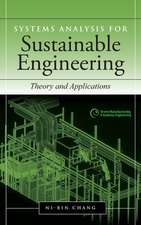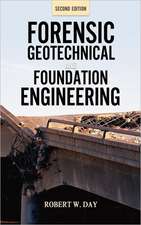Structural Dynamics: Theory and Computation
Autor Mario Paz, William Leighen Limba Engleză Paperback – 18 apr 2013
"The
Fifth
Edition
of
Structural
Dynamics:
Theory
and
Computation
is
the
complete
and
comprehensive
text
in
the
field.
It
presents
modern
methods
of
analysis
and
techniques
adaptable
to
computer
programming
clearly
and
easily.
The
book
is
ideal
as
a
text
for
advanced
undergraduates
or
graduate
students
taking
a
first
course
in
structural
dynamics.
It
is
arranged
in
such
a
way
that
it
can
be
used
for
a
one-
or
two-semester
course,
or
span
the
undergraduate
and
graduate
levels.
In
addition,
this
text
will
serve
the
practicing
engineer
as
a
primary
reference.
The
text
differs
from
the
standard
approach
of
other
presentations
in
which
topics
are
ordered
by
their
mathematical
complexity.
This
text
is
organized
by
the
type
of
structural
modeling.
The
author
simplifies
the
subject
by
presenting
a
single
degree-of-freedom
system
in
the
first
chapters,
then
moves
to
systems
with
many
degrees-of-freedom
in
the
following
chapters.
Finally,
the
text
moves
to
applications
of
the
first
chapters
and
special
topics
in
structural
dynamics.
New
in
this
Edition:
- Problems reworked for SAP2000®.
- Step-by-step examples of how to use SAP2000® for every application of structural dynamics.
- Inclusion of companion Web site (extras.springer.com/2004) with three learning aids: SAP2000® student version; source code for the author’s educational programs in structural dynamics, so that the results of changed parameters can be seen step-by-step; and the compiler (executable files) for the author’s educational programs.
- Three earthquake engineering chapters updated to the latest ICC® building codes.
- Materials rearranged so that theory and dynamic analysis precede applications and special topics, facilitating using the book sequentially.
- Complete instructions provided to advanced topics as foundation for further study.
This
text
is
essential
for
civil
engineering
students.
Professional
civil
engineers
will
find
it
an
ideal
reference."
| Toate formatele și edițiile | Preț | Express |
|---|---|---|
| Paperback (1) | 594.25 lei 38-44 zile | |
| Springer Us – 18 apr 2013 | 594.25 lei 38-44 zile | |
| Hardback (1) | 920.98 lei 43-57 zile | |
| Springer Us – 30 noi 2003 | 920.98 lei 43-57 zile |
Preț: 594.25 lei
Preț vechi: 781.90 lei
-24% Nou
Puncte Express: 891
Preț estimativ în valută:
113.75€ • 123.59$ • 95.61£
113.75€ • 123.59$ • 95.61£
Carte tipărită la comandă
Livrare economică 16-22 aprilie
Preluare comenzi: 021 569.72.76
Specificații
ISBN-13: 9781461350989
ISBN-10: 1461350980
Pagini: 836
Dimensiuni: 155 x 235 x 44 mm
Greutate: 1.23 kg
Ediția:5th ed. 2004
Editura: Springer Us
Colecția Springer
Locul publicării:New York, NY, United States
ISBN-10: 1461350980
Pagini: 836
Dimensiuni: 155 x 235 x 44 mm
Greutate: 1.23 kg
Ediția:5th ed. 2004
Editura: Springer Us
Colecția Springer
Locul publicării:New York, NY, United States
Public țintă
ResearchDescriere
solution
of
structural
dynamics
problems
is
introduced
in
this
new
edition.
This
program
was
selected
from
among
the
various
professional
programs
available
because
of
its
capability
in
solving
complex
problems
in
structures
as
well
as
its
wide
use
in
professional
practice
by
structural
engineers.
SAP2000
includes
routines
for
the
analysis
and
design
of
structures
with
linear
or
nonlinear
behavior
subjected
to
static
or
dynamics
loads;
(material
non-linearity
or
large
displacements
non-linearities)
and
may
be
used
most
efficiently
in
the
microcomputer.
The
larger
versions
of
SAP2000
have
the
capability
for
the
analysis
of
structures
modeled
with
virtually
any
large
number
of
nodes.
This
new
fifth
edition
of
the
book
uses,
almost
exclusively,
the
introductory
version
of
SAP2000
which
has
a
capability
limited
to
25
nodes
or
25
elements.
A
CD
ROM
containing
the
introductory
version
of
SAP2000
as
well
as
the
educational
set
of
th
the
program
developed
by
the
author
is
included
in
this
5
edition
of
Structural
Dynamics:
Theory
and
Computation.
The
set
of
educational
programs
in
Structural
Dynamics
includes
programs
to
determine
the
response
in
the
time
domain
or
in
the
frequency
domain
using
the
FFT
(Fast
Fourier
Transform)
of
structures
modeled
as
a
single
oscillator.
Also
included
is
a
program
to
determine
the
response
of
an
inelastic
system
with
elastoplastic
behavior,
and
another
program
for
the
development
of
seismic
response
spectral
charts.
Cuprins
I
Structures
Modeled
as
a
Single-Degree-of-Freedom
System.-
1
Undamped
Single-Degree-Of-Freedom
System.-
1.1
Degrees
of
Freedom.-
1.2
Undamped
System.-
1.3
Springs
in
Parallel
or
in
Series.-
1.4
Newton’s
Law
of
Motion.-
1.5
Free
Body
Diagram.-
1.6
D’
Alembert’s
Principle.-
1.7
Solution
of
the
Differential
Equation
of
Motion.-
1.8
Frequency
and
Period.-
1.9
Amplitude
of
Motion.-
1.10
Summary.-
1.11
Problems.-
2
Damped
Single-Degree-of-Freedom
System.-
2.1
Viscous
Damping.-
2.2
Equation
of
Motion.-
2.3
Critically
Damped
System.-
2.4
Overdamped
System.-
2.5
Underdamped
System.-
2.6
Logarithmic
Decrement.-
2.7
Summary.-
2.8
Problems.-
3
Response
of
One-Degree-of-Freedom
System
to
Harmonic
Loading.-
3.1
Harmonic
Excitation:
Undamped
System.-
3.2
Harmonic
Excitation:
Damped
System.-
3.3
Evaluation
of
Damping
at
Resonance.-
3.4
Bandwidth
Method
(Half-Power)
to
Evaluate
Damping.-
3.5
Energy
Dissipated
by
Viscous
Damping.-
3.6
Equivalent
Viscous
Damping.-
3.7
Response
to
Support
Motion.-
3.8
Force
Transmitted
to
the
Foundation.-
3.9
Seismic
Instruments.-
3.10
Response
of
One-Degree-of-Freedom
System
to
Harmonic
Loading
Using
SAP2000.-
3.11
Summary.-
3.12
Analytical
Problem.-
3.13
Problems.-
4
Response
to
General
Dynamic
Loading.-
4.1
Duhamel’s
Integral-Undamped
System.-
4.2
Duhamel’s
Integral
-Damped
System.-
4.3
Response
by
Direct
Integration.-
4.4
Solution
of
the
Equation
of
Motion.-
4.5
Program
2-Response
by
Direct
Integration.-
4.6
Program
3-Response
to
Impulsive
Excitation.-
4.7
Response
to
General
Dynamic
Loading
Using
SAP2000.-
4.8
Summary.-
4.9
Analytical
Problems.-
4.10
Problems.-
5
Response
Spectra.-
5.1
Construction
of
Response
Spectrum.-
5.2
Response
Spectrum
for
Support
Excitation.-
5.3
Tripartite
Response
Spectra.-
5.4
Response
Spectra
for
Elastic
Design.-
5.5
Influence
of
Local
Soil
Conditions.-
5.6
Response
Spectra
for
Inelastic
Systems.-
5.7
Response
Spectra
for
Inelastic
Design.-
5.8
Program
6-Seismic
Response
Spectra.-
5.9
Summary.-
5.10
Problems.-
6
Nonlinear
Structural
Response.-
6.1
Nonlinear
Single
Degree-of-Freedom
Model.-
6.2
Integration
of
the
Nonlinear
Equation
of
Motion.-
6.3
Constant
Acceleration
Method.-
6.4
Linear
Acceleration
Step-by-Step
Method.-
6.5
The
Newmark
Beta
Method.-
6.6
Elastoplastic
Behavior.-
6.7
Algorithm
for
the
Step-by-Step
Solution
for
Elastoplastic
Single-Degree-of-Freedom
System.-
6.8
Program
5-Response
for
Elastoplastic
Behavior.-
6.9
Summary.-
6.10
Problems.-
II
Structures
Modeled
as
Shear
Buildings.-
7
Free
Vibration
of
a
Shear
Building.-
7.1
Stiffness
Equations
for
the
Shear
Building.-
7.2
Natural
Frequencies
and
Normal
Modes.-
7.3
Orthogonality
Property
of
the
Normal
Modes.-
7.4
Rayleigh’s
Quotient.-
7.5
Program
8-Natural
Frequencies
and
Normal
Modes.-
7.6
Free
Vibration
of
a
Shear
Building
Using
SAP2000.-
7.7
Summary.-
7.8
Problems.-
8
Forced
Motion
of
Shear
Building.-
8.1
Modal
Superposition
Method.-
8.2
Response
of
a
Shear
Building
to
Base
Motion.-
8.3
Program
9-Response
by
Modal
Superposition.-
8.4
Harmonic
Forced
Excitation.-
8.5
Program
10-Harmonic
Response.-
8.6
Forced
Motion
Using
SAP2000.-
8.7
Combining
Maximum
Values
of
Modal
Response.-
8.8
Summary.-
8.9
Problems.-
9
Reduction
of
Dynamic
Matrices.-
9.1
Static
Condensation.-
9.2
Static
Condensation
Applied
to
Dynamic
Problems.-
9.3
Dynamic
Condensation.-
9.4
Modified
Dynamic
Condensation.-
9.5
Program
12-Reduction
of
the
Dynamic
Problem.-
9.6
Summary.-
9.7
Problems.-
III
Framed
Structures
Modeled
as
Discrete
Multi-Degree-of-Freedom
Systems.-
10
Dynamic
Analysis
of
Beams.-
10.1
Shape
Functions
for
a
Beam
Segment.-
10.2
System
Stiffness
Matrix.-
10.3
Inertial
Properties-Lumped
Mass.-
10.4
Inertial
Properties-Consistent
Mass.-
10.5
Damping
Properties.-
10.6
External
Loads.-
10.7
Geometric
Stiffness.-
10.8
Equations
of
Motion.-
10.9
Element
Forces
at
Nodal
Coordinates.-
10.10
Program
13-Modeling
Structures
as
Beams.-
10.11
Dynamic
Analysis
of
Beams
Using
SAP2000.-
10.12
Summary.-
10.13
Problems.-
11
Dynamic
Analysis
of
Plane
Frames.-
11.1
Element
Stiffness
Matrix
for
Axial
Effects.-
11.2
Element
Mass
Matrix
for
Axial
Effects.-
11.3
Coordinate
Transformation.-
11.4
Program
14-Modeling
Structures
as
Plane
Frames.-
11.5
Dynamic
Analysis
of
Frames
Using
SAP2000.-
11.6
Summary.-
11.7
Problems.-
12
Dynamic
Analysis
of
Grid
Frames.-
12.1
Local
and
Global
Coordinate
Systems.-
12.2
Torsional
Effects.-
12.3
Stiffness
Matrix
for
a
Grid
Element.-
12.4
Consistent
Mass
Matrix
for
a
Grid
Element.-
12.5
Lumped
Mass
Matrix
for
a
Grid
Element.-
12.6
Transformation
of
Coordinates.-
12.7
Program
15-Modeling
Structures
as
Grid
Frames.-
12.8
Dynamic
Analysis
of
Grid
Frames
Using
SAP2000.-
12.9
Summary.-
12.10
Problems.-
13
Dynamic
Analysis
Ofthree-Dimensional
Frames.-
13.1
Element
Stiffness
Matrix.-
13.2
Element
Mass
Matrix.-
13.3
Element
Damping
Matrix.-
13.4
Transformation
of
Coordinates.-
13.5
Differential
Equation
of
Motion.-
13.6
Dynamic
Response.-
13.7
Program
16-Modeling
Structures
as
Space
Frames.-
13.8
Dynamic
Response
of
Three-Dimensional
Frames
Using
SAP2000.-
13.9
Summary.-
13.10
Problems.-
14
Dynamic
Analysis
of
Trusses.-
14.1
Stiffness
and
Mass
Matrices
for
the
Plane
Truss.-
14.2
Transformation
of
Coordinates.-
14.3
Program
17-Modeling
Structures
as
Plane
Trusses.-
14.4
Stiffness
and
Mass
Matrices
for
Space
Trusses.-
14.5
Equation
of
Motion
for
Space
Trusses.-
14.6
Program
18-Modeling
Structures
as
Space
Trusses.-
14.7
Dynamic
Analysis
of
Trusses
Using
SAP2000.-
14.8
Summary.-
14.9
Problems.-
15
Dynamic
Analysis
of
Structures
Using
the
Finite
Element
Method.-
15.1
Plane
Elasticity
Problems.-
15.1.1
Triangular
Plate
Element
for
Plane
Elasticity
problems.-
15.1.2
SAP2000for
Plane
Elasticity
Problem.-
15.2
Plate
Bending.-
15.2.1
Rectangular
Element
for
Plate
Bending.-
15.2.2
SAP2000
for
Plate
Bending
and
Shell
Problems.-
15.3
Summary.-
15.4
Problems.-
16
Time
History
Response
of
Multidegree-of-Freedom
Systems.-
16.1
Incremental
Equations
of
Motion.-
16.2
The
Wilson-?
Method.-
16.3
Algorithm
for
Step-by-Step
Solution
of
a
Linear
System
Using
the
Wilson-?
Method.-
16.3.1
Initialization.-
16.3.2
for
Each
Time
Step.-
16.4
Program
19-Response
by
Step
Integration.-
16.5
The
Newmark
Beta
Method.-
16.6
Elastoplastic
Behavior
of
Framed
Structures.-
16.7
Member
Stiffness
Matrix.-
16.8
Member
Mass
Matrix.-
16.9
Rotation
of
Plastic
Hinges.-
16.10
Calculation
of
Member
Ductility
Ratio.-
16.11
Time-History
Response
of
Multidegree-of-Freedom
Systems
Using
SAP2000.-
16.12
Summary.-
16.13
Problems.-
IV
Structures
Modeled
with
Distributed
Properties.-
17
Dynamic
Analysis
of
Systems
with
Distributed
Properties.-
17.1
Flexural
Vibration
of
Uniform
Beams.-
17.2
Solution
of
the
Equation
of
Motion
in
Free
Vibration.-
17.3
Natural
Frequencies
and
Mode
Shapes
for
Uniform
Beams.-
17.3.1
Both
Ends
Simply
Supported.-
17.3.2
Both
Ends
Free
(Free
Beam).-
17.3.3
Both
Ends
Fixed.-
17.3.4
One
End
Fixed
and
the
other
End
Free
(Cantilever
Beam).-
17.3.5
One
End
Fixed
and
the
other
End
Simply
Supported.-
17.4
Orthogonality
Condition
Between
Normal
Modes.-
17.5
Forced
Vibration
of
Beams.-
17.6
Dynamic
Stresses
in
Beams.-
17.7
Summary.-
17.8
Problems.-
18
Discretization
of
Continuous
Systems.-
18.1
Dynamic
Matrix
for
Flexural
Effects.-
18.2
Dynamic
Matrix
for
Axial
Effects.-
18.3
Dynamic
Matrix
for
Torsional
Effects.-
18.4
Beam
Flexure
Including
Axial-Force
Effect.-
18.5
Power
Series
Expansion
of
the
Dynamic
Matrix
for
Flexural
Effects.-
18.6
Power
Series
Expansion
of
the
Dynamic
Matrix
for
Axial
and
for
Torsional
Effects.-
18.7
Power
Series
Expansion
of
the
Dynamic
Matrix
Including
the
Effects
of
Axial
Forces.-
18.8
Summary.-
V
Special
Topics:
Fourier
Analysis,
Evaluation
of
Absolute
Damping,
Generalized
Coordinates.-
19
Fourier
Analysis
and
Response
in
the
Frequency
Domain.-
19.1
Fourier
Analysis.-
19.2
Response
to
a
Loading
Represented
by
Fourier
Series.-
19.3
Fourier
Coefficients
for
Piecewise
Linear
Functions.-
19.4
Exponential
Form
of
Fourier
Series.-
19.5
Discrete
Fourier
Analysis.-
19.6
Fast
Fourier
Transform.-
19.7
Program
4-Response
in
the
Frequency
Domain.-
19.8
Summary.-
19.9
Problems.-
20
Evaluation
of
Absolute
Damping
from
Modal
Damping
Ratios.-
20.1
Equations
for
Damped
Shear
Building.-
20.2
Uncoupled
Damped
Equations.-
20.3
Conditions
for
Damping
Uncoupling.-
20.4
Program
11-Absolute
Damping
From
Modal
Damping
Ratios.-
20.5
Summary.-
20.6
Problems.-
21
Generalized
Coordinates
and
Rayleigh’s
Method.-
21.1
Principle
of
Virtual
Work.-
21.2
Generalized
Single-Degree-of-Freedom
System-Rigid
Body.-
21.3
Generalized
Single-Degree-of-Freedom
System-Distributed
Elasticity.-
21.4
Shear
Forces
and
Bending
Moments.-
21.5
Generalized
Equation
of
Motion
for
a
Multistory
Building.-
21.6
Shape
Function.-
21.7
Rayleigh’s
Method.-
21.8
Improved
Rayleigh
’
s
Method.-
21.9
Shear
Walls.-
21.10
Summary.-
21.11
Problems.-
VI
Random
Vibration.-
22
Random
Vibration.-
22.1
Statistical
Description
of
Random
Functions.-
22.2
Probability
Density
Function.-
22.3
The
Normal
Distribution.-
22.4
The
Rayleigh
Distribution.-
22.5
Correlation.-
22.6
The
Fourier
Transform.-
22.7
Spectral
Analysis.-
22.8
Spectral
Density
Function.-
22.9
Narrow-Band
and
Wide-Band
Random
processes.-
22.10
Response
to
Random
Excitation:
Single-Degree-of-Freedom
System.-
22.11
Response
to
Random
Excitation:
Multiple-Degree-of-Freedom
System.-
22.11.1
Relationship
Between
Complex
Frequency
Response
and
Unit
Impulse
Response.-
22.11.2
Response
to
Random
Excitation:
Two-degree-of-freedom
System.-
22.11.3
Response
to
Random
Excitation:
N
Degree
of
Freedom
System.-
22.12
Summary.-
22.13
Problems.-
VII
Earthquake
Engineering.-
23
Uniform
Building
Code
1997:
Equivalent
Lateral
Force
Method.-
23.1
Earthquake
Ground
Motion.-
23.2
Equivalent
Lateral
Force
Method.-
23.3
Earthquake-Resistant
Design
Methods.-
23.4
Seismic
Zone
Factor.-
23.5
Base
Shear
Force.-
23.6
Distribution
of
Lateral
Seismic
Forces.-
23.7
Story
Shear
Force.-
23.8
Horizontal
Torsional
Moment.-
23.9
Overturning
Moment.-
23.10
P-Delta
Effect
(P-?).-
23.11
Redundancy/Reliability
Factor
p.-
23.12
Story
Drift
Limitation.-
23.13
Diaphragm
Design
Forces.-
23.14
Earthquake
Load
Effect.-
23.15
Irregular
Structures.-
23.16
Summary.-
23.17
Problems.-
24
Uniform
Building
Code
1997:
Dynamic
Method.-
24.1
Modal
Seismic
Response
of
Buildings.-
24.1.1
Modal
Equation
and
Participation
Factor.-
24.1.2
Modal
Shear
Force.-
24.1.3
Effective
Modal
Weight.-
24.1.4
Modal
Lateral
Forces.-
24.1.5
Modal
Displacements.-
24.1.6
Modal
Drift.-
24.1.7
Modal
Overturning
Moment.-
24.1.8
Modal
Torsional
Moment.-
24.2
Total
Design
Values.-
24.3
Provisions
of
UBC-97:
Dynamic
Method.-
24.4
Scaling
of
Results.-
24.5
Program
24-UBC
1997
Dynamic
Lateral
Force
Method.-
24.6
Summary.-
24.7
Problems.-
25
International
Building
Code
IBC-2000.-
25.1
Response
Spectral
Acceleration:
SS,
S1.-
25.2
Soil
Modification
Response
Spectral
Acceleration:
SMS,
SM1.-
25.3
Design
Response
Spectral
Acceleration:
SDS,
SD1.-
25.4
Site
Class
Definition:
A,
B,.....F.-
25.5
Seismic
Use
Group
(SUG)
and
Occupancy
Importance
Factor
(IE).-
25.6
Seismic
Design
Category
(A,
B,
C,
D,
E
and
F).-
25.7
Design
Response
Spectral
Curve:
Sa
v.s.
T.-
25.8
Determination
of
the
Fundamental
Period.-
25.9
Minimum
lateral
Force
Procedure
[IBC-2000:
Section
1616.4.1].-
25.10
Simplified
Analysis
Procedure
[IBC-2000:
Section
1617.5].-
25.10.1
Seismic
Base
Shear.-
25.10.2
Response
Modification
Factor
R.-
25.10.3
Vertical
Distribution
of
Lateral
Forces.-
25.11
Equivalent
Seismic
Lateral
Force
Method:
[IBC-2000:
Section
1617.4].-
25.11.1
Distribution
of
Lateral
Forces.-
25.11.2
Overturning
Moments.-
25.11.3
Horizontal
Torsional
Moment.-
25.11.4
P-Delta
Effect
(P-?).-
25.11.5
Story
Drift.-
25.12
Redundancy/Reliability
Factor.-
25.13
Earthquake
Load
Effect.-
25.14
Building
Irregularities.-
25.15
Summary.-
Appendices.-
Appendix
I:
Answers
to
Problems
in
Selected
Chapters.-
Appendix
II:
Computer
Programs.-
Appendix
III:
Glossary.-
Selected
Bibliography.
Textul de pe ultima copertă
"The
Fifth
Edition
of
Structural
Dynamics:
Theory
and
Computation
is
the
complete
and
comprehensive
text
in
the
field.
It
presents
modern
methods
of
analysis
and
techniques
adaptable
to
computer
programming
clearly
and
easily.
The
book
is
ideal
as
a
text
for
advanced
undergraduates
or
graduate
students
taking
a
first
course
in
structural
dynamics.
It
is
arranged
in
such
a
way
that
it
can
be
used
for
a
one-
or
two-semester
course,
or
span
the
undergraduate
and
graduate
levels.
In
addition,
this
text
will
serve
the
practicing
engineer
as
a
primary
reference.
The
text
differs
from
the
standard
approach
of
other
presentations
in
which
topics
are
ordered
by
their
mathematical
complexity.
This
text
is
organized
by
the
type
of
structural
modeling.
The
author
simplifies
the
subject
by
presenting
a
single
degree-of-freedom
system
in
the
first
chapters,
then
moves
to
systems
with
many
degrees-of-freedom
in
the
following
chapters.
Finally,
the
text
moves
to
applications
of
the
first
chapters
and
special
topics
in
structural
dynamics.
New
in
this
Edition:
- Problems reworked for SAP2000®.
- Step-by-step examples of how to use SAP2000® for every application of structural dynamics.
- Inclusion of companion Web site (extras.springer.com/2004) with three learning aids: SAP2000® student version; source code for the author’s educational programs in structural dynamics, so that the results of changed parameters can be seen step-by-step; and the compiler (executable files) for the author’s educational programs.
- Three earthquake engineering chapters updated to the latest ICC® building codes.
- Materials rearranged so that theory and dynamic analysis precede applications and special topics, facilitating using the book sequentially.
- Complete instructions provided to advanced topics as foundation for further study.
This
text
is
essential
for
civil
engineering
students.
Professional
civil
engineers
will
find
it
an
ideal
reference."
Caracteristici
Is
interesting
as
well
as
scholarly
and
encourages
the
reader
to
continue
rather
than
to
put
it
down










